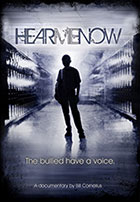
Hear Me Now 2015
Distributed by Green Planet Films, PO Box 247, Corte Madera, CA 94976-0247; 415-377-5471
Produced by Bill Cornelius, Zac Adams, Steven C. Knapp, and Mike Stryker
Directed by Bill Cornelius
DVD , color, 51 min.
Middle School - General Adult
Adolescence, Child Development, Children, Teacher Training
Date Entered: 11/30/2016
Reviewed by Mary Northrup, Metropolitan Community College-Maple Woods, Kansas City, MissouriThis powerful documentary addresses the problem of school bullying. Students talk directly to the camera about their experiences with this very contemporary issue. As well, a number of adults also talk about their experiences: a musician, teachers, an author, founders of anti-bullying programs, filmmakers, an artist, parents, and a therapist. Interspersed are scenes of bullying taking place in school; by the age of the students participating either as speakers or in the filmed scenes, the target audience appears to be middle school and high school.
As the students and the adults tell what happened when they were bullied, the viewer learns why someone bullies, what it feels like to be bullied, and the consequences, both emotional and physical. Some of the most difficult stories heard here include those in which teachers, coaches, and counselors are the bullies.
One section of the film addresses cyberbullying, how pervasive it is in students’ lives, and how it could possibly be handled by parents.
One of the most heartbreaking sections of the film concerns that of suicidal thoughts and intents, related by the adults and the students, including what they did to themselves and what they intended to but never carried out. The story here of a father who lost a child to suicide after being bullied will move some viewers to tears.
This documentary, finely produced with great visuals and sound, as well as a much-needed message, attempts to speak directly to students who are being bullied. Middle school and high school counselors may want to use it in their programs. Public libraries may also want to consider it for their collections. College students in education and counseling classes may want to view it to help them when they become teachers and counselors.
The film ends on a hopeful note, with some solutions, either individual – some students turn to personal interests, such as music – or through programs and organizations which are spreading the anti-bullying message.
The use of students the same age as potential viewers of the film provides a way for those students watching to relate to the message of the film. Some of the adult speakers appear to be in their twenties or thirties, which may also help their message reach students.
Of course, one movie will not change the world, but this film, in conjunction with alert parents, sympathetic teachers, strong principals, and possibly speakers or organizations brought in to present the subject, may save some students from the torture of bullying.